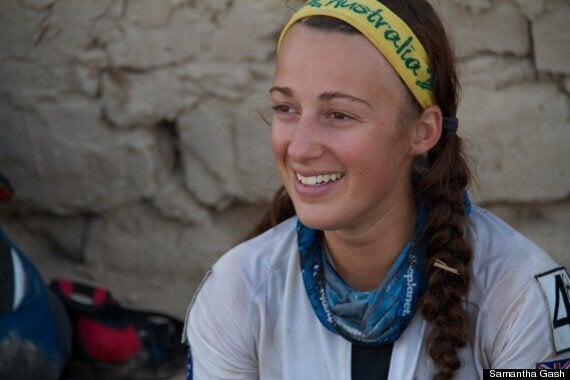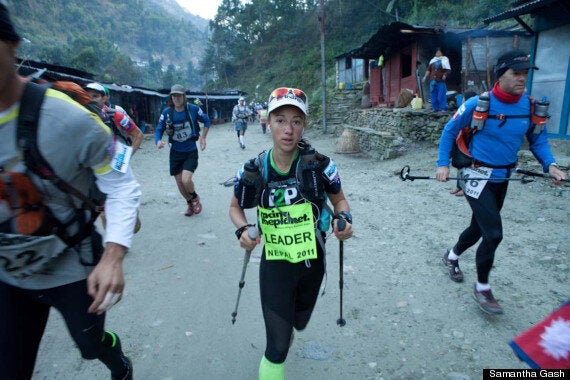Imagine running a marathon.
Now imagine doing that four times over, plus some. In the harshest environments on earth. That’s exactly what 29-year-old Samantha Gash did, covering a total of 1,000km across deserts in Chile, Egypt, China and the Antarctic.
The Melbourne-based lawyer is the first female and youngest person ever to have completed the Four Desert Grand Slam, which is (unsurprisingly) the most extreme race on earth.
Competitors run 250km in each desert, in seven days. They camp out in the open, navigate on their own, and carry everything they need on their back.

“It’s all about your mindset,” says Sam. “Nothing can prepare you for what you’re going to experience out there. But it’s about bucking up everyday and just going for it.”
The young woman blazed through the Sahara in searing heat – “it’s like having ten hairdryers pointed at you,” - and she endured razor-sharp wind in the Antarctic so cold, it hazed her memory of reaching the finish line.
But the sense of achievement is unforgettable and came as a complete surprise, even to her.
“When I ran my first marathon, I found it incredibly difficult,” says Sam. “I didn’t come from a very sporty background. In fact I’m quite uncoordinated.”
It’s hard to believe these words coming from one of the toughest endurance runners on earth, but it proves the strength of mental resolve – and the power of determination.
“The next day I met a woman in her fifties who had run three marathons back-to-back, and was thinking of doing a fourth – I couldn’t even walk up the stairs!
"I was intrigued by how someone could mentally get up and run again each day. I think that’s what sparked my curiosity about the Grand Slam. And I loved the adventure side of going to some really remote places.”
Sam began training six days a week. Long-distance running, yoga and working on her strength were included but she says that for her, mental preparation was key.
“I would visualise some of the challenges I might encounter,” she explains. “I’d imagine what it would feel like to be as hot as you possibly could be. And then I’d train myself to ignore it.”
But being faced with the harsh realities en route was still trying. “I felt new depths of pain,” Sam explains. “There were moments in the race when I wondered what I was doing. When I was so dehydrated it hurt. Or when I thought it was 12km more to a checkpoint but it was actually 14.
"In those times it was hard to keep going. But I would just tell myself that I chose to do this; that I wanted to be here. I really never let myself contemplate giving up. Plus – I’m a sucker for a sunset in the desert.”

Samantha said the race took her places on earth she could have never imagined – the surreal reflective surface of the salt flats in Chile, ragged mountains that spiral into the clouds in China, and the rolling sand dunes of the Sahara that pummel into the deep blue sky. But she also had some tough times, with one particularly harrowing incident.
Three days into her run in the Egyptian Sahara, Samantha was attacked. She was dragged into the bushes by a man who was waiting on her side of the course. Luckily a moped drove by before he was able to assault her, but the ordeal shook her to her core.
Still a good distance from the nearest checkpoint, Samantha was left in a blind panic, terrified and alone in the desert.
It took 45 minutes for someone from the team to find her, and take her back to the camp. Samantha said the experience did make her “question what (she) was doing.” “
But when her teammates arrived back at the tents, and she spoke to her family on the satellite phone, her nerves of steel and unrivaled determination kicked in.
“I wasn’t going to go home telling people that I had completed the race, but not having done 250km of it,” she explains. "Because that’s what I had signed up to do.”
The next day, Samantha was driven to the point in the desert where she had stopped, and completed the course. A few months later, she arrived in Antarctic, eager to face the icebergs along the final leg and finish the race for good.
“I was in shock at first,” explains Samantha. “I couldn’t believe I’d done it. I got to see some spectacular places. But for me it was also about the people I met.”
With evenings to fill once the day’s run was over, and very little to do - “you had to carry everything on your back so we didn’t have games or even a deck of cards!” – Sam said she grew incredibly close to her teammates.
“You can imagine, all the barriers of normal friendship fall away in the desert.” She laughs and tries to describe their daily blister check and foot cleaning routine without going in to the gory details. “You really get to know each other.”
Samantha has stayed in touch with many of her teammates, and running continues to be an important part of her life. In September of this year, she and a friend will embark on a 2,350km run along the Freedom Trail in South Africa in aid of charity.
Funds raised will go towards their initiative, Freedom Runners, which aims to improve access to sanitary products for young women in Africa, who often miss school as result of being poorly equipped or stigmatized. The running partners will also feature in a documentary about their epic journey.
“In a way, my life revolves around running, but through it I’ve raised money for charity, met some amazing people, and have set up a social enterprise business,” says Samantha.
“If I knew what I was getting myself into I might not have done it. But now that I have, it feels magical.”